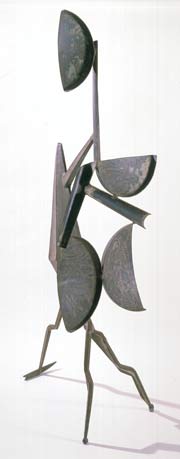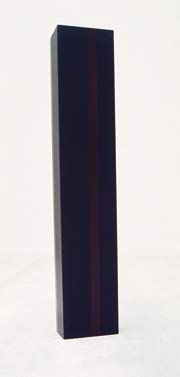Next story: Battle of Original Music: Second Round Quarterfinalists
Action/Abstraction: Pollock, de Kooning, and American Art 1940-1976
by K. O'Day
The opposing philosophies of two of this watershed period's foremost art critics, Clement Greenberg and Harold Rosenberg.
|
On Tuesday, AV got a preview of one of the Albright-Knox Art Gallery’s most expansive, stylistically comprehensive, and culturally thoughtful exhibitions in...well, read on. Feuds, quarrels, battles of words, mutual animosity, whatever you want to call it—such disagreements are rich fodder for legend. Bills vs. Miami aside (to pour proverbial salt in the local wounds), it’s probably the rivalries between the intellectual cogniscenti in the past centuries that are the nastiest on record. The correspondences between Lillian Hellman vs. Mary McCarthy illustrate rather well the line between mutual respect and mutual disrespect, but there was another famous, ongoing difference of opinion that went on around the same era, the dialogue of which helped to form what we now refer to as the modern art world. It also formed and informed the American culture at large—as this exhibition certainly shows—in the sense that art does imitate reality, and vice-versa. Although Pollock and de Kooning get top billing, this exhibition honors not only the requisite all-star cast but an array of nationally lesser-known artists, those whose impact is arguably of equal importance but whose legacies haven’t been overshadowed by those tortured, bad-boy antics or quirky, reclusive oddities that feed the star-making machine. So we get Mark Rothko and Jasper Johns along with de Kooning and Pollock—as well we should. But we also get some pioneering sculptors and what we’d almost call “outsider artists.” (See the cover of this week's print edition, Funeral Heart, enamel on plaster-soaked muslin by Claes Oldenberg, representative of work he used to sell in his lower east side Manhattan store.) The exhibition, which was originally conceived by Norman L. Kleeblatt of New York City’s Jewish Museum, and has been somewhat reconfigured with the architecture of the Albright in mind by Dreishpoon, opens on Friday, February 13, as part of the Albright Kox’s Gusto at the Gallery Free Friday series —k. o’day |

David Smith's Tanktotem IV

Anne Truitt's Essex
|
Artists included in this exhibition are:Lee Bontecou Anthony Caro Hebert Ferber Helen Frankenthaler Arshile gorky Philip Guston David Hare Grace Hartigan Hans Hofmann Jasper Johns Allan Kaprow/Martha Rosler Willem de Kooning Lee Krasner Ibram Lassaw Norman Lewis Seymour Lipton Morris Louis Joan Mitchell Barnett Newman Kenneth Noland Claes Oldenburg Jules Olitski Jackson Pollock Ad Reinhardt Mark Rothko Peter Saul David Smith Saul Steinberg Frank Stella Clyfford Still Anne Truitt |
|
A look behind the scenes at AVTV shows the installation of this prestigious travelling exhibition, with a tour by Albright-Knox curator Douglas Dreishpoon. See more video on AVTV's Art Channel |

Philip Guston's Ancient Wall. Oil on canvas 1976. Guston went to high school with Jackson Pollock.
|
The conception of the exhibition was a brainstorming session between Norman Kleebatt, who’s the curator of the Jewish Museum, and myself in July 2006.
He talked about wanting to do a show that would be a revisionist look at the period postwar American art, beginning in 1945 and ending somewhere in the 1970s. He was interested in our collaboration. He thought, rightly so, that the gallery has a treasure trove of works from this period.
The period we’re talking about really begins in 1945, and in some ways is contingent on the bombing of Nagasaki and Hiroshima.
The point at which they dropped the atomic bomb, the world was in a very different place. Suddenly there was this combination of scientific sophistication and a reversion to the most primitive, atavistic death-dealing. On the one hand you had science and on the other death, and the two came together in this way thatc reated a certain mindset and a certain anxiety that is played out in some of this work.
Harold Rosenberg coined a phrase, “action painting,” and the phrase came to bear on a notion that the canvas was an arena on to which the artists enacted their drama of creation.”
Greenberg was more interested in the formal qualities of the work. Less interested in process, less interested in everything the revolves around being the human being painting the object, and more interested in the final product and what comes to bear on making that an mage: form, line, color.
It became a rather rarefied approach because it was less about psychology, biography, culture, and more about thing itself. The work of art is on a cloud floating above the base plane of culture.
—Douglas Dreishpoon

Jackson Pollock's Convergence, a familiar installation at the Gallery, was reinstalled for this exhibition.
|
Special thanks to Susana Tejada, head of Research Resources at the Albright-Knox, who coordinated Brave Buffalo, a manuscript exhibition in conjunction with Action/Abstraction, that details the city’s—and the gallery’s—relationship to furthering the abstract expressionist movement in America.
blog comments powered by Disqus
|
Issue Navigation> Issue Index > v8n6 (week of Thursday, February 5, 2009) > Action/Abstraction: Pollock, de Kooning, and American Art 1940-1976 This Week's Issue • Artvoice Daily • Artvoice TV • Events Calendar • Classifieds |









 Current Issue
Current Issue